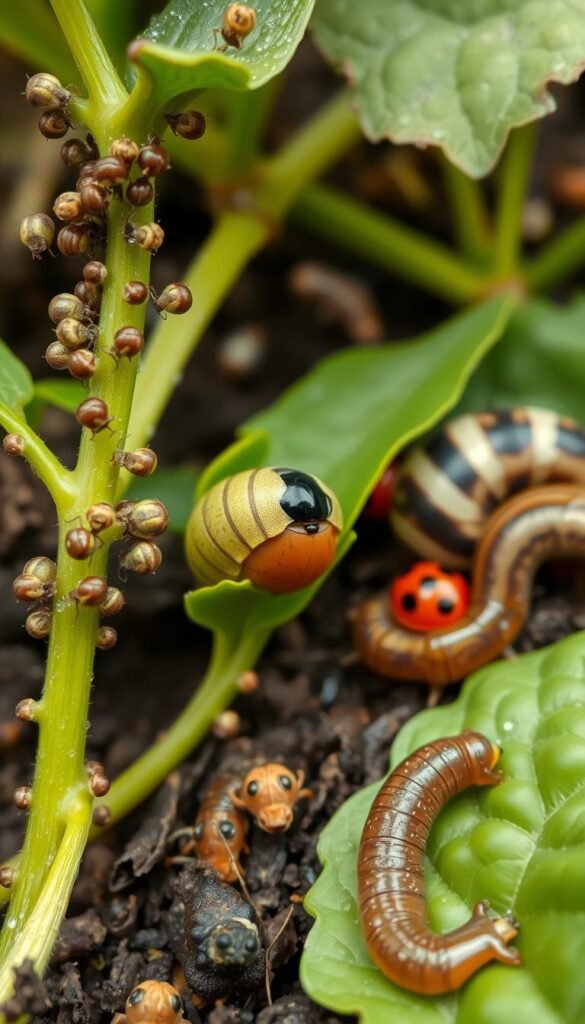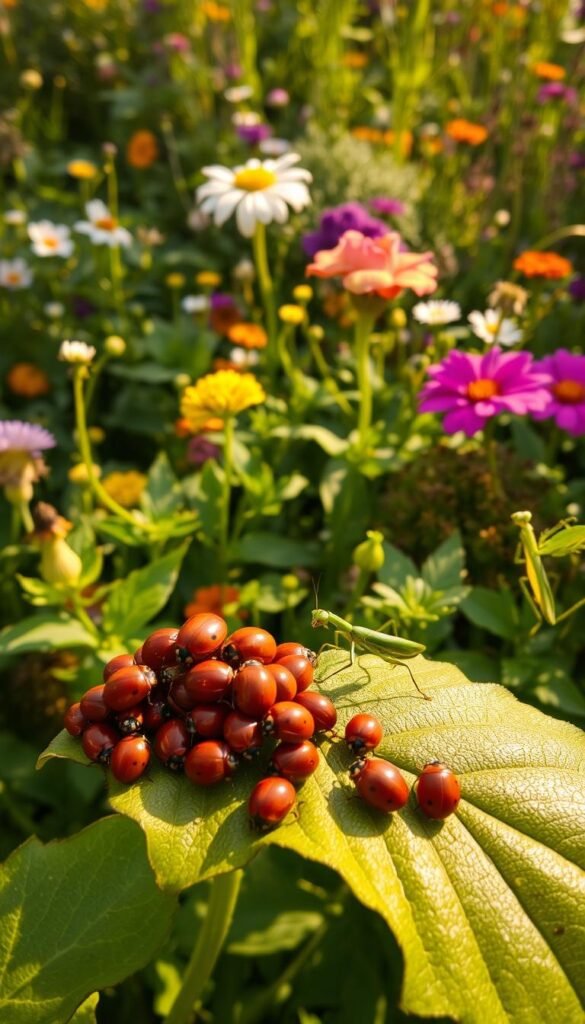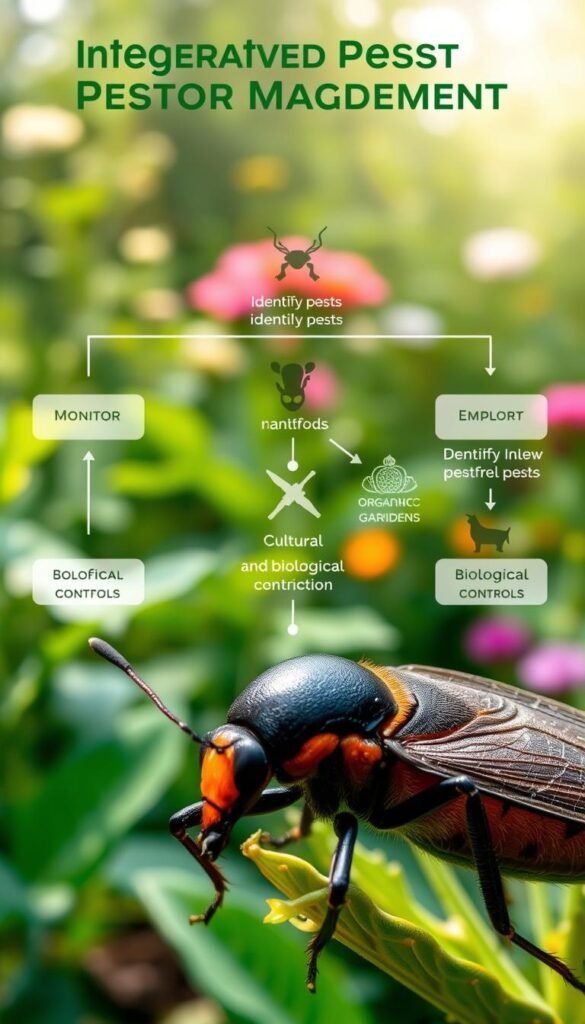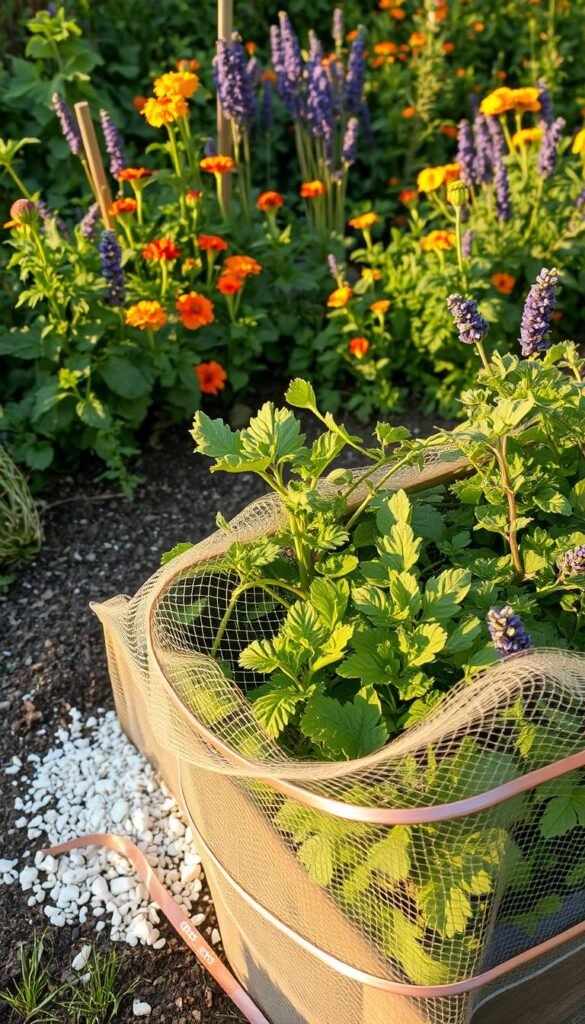Dealing with unwanted visitors in your yard doesn’t mean reaching for toxic sprays. Nature already has smart ways to keep things balanced. Take raccoons, for example—they’ll avoid areas that smell like predators. A Nashville gardener once used coyote urine (or even human hair) to scare them off successfully.
This guide focuses on eco-friendly methods that work with nature, not against it. You’ll learn how to protect your plants while keeping families and pets safe. No complex tools or expensive treatments are needed—just simple, effective strategies.
Whether you’re new to gardening or just want safer alternatives, these tips help create a thriving space. Let’s explore how small changes can make a big difference.
Why Choose Organic Pest Control for Beginners?

A thriving garden starts with balance—not harsh chemicals that harm more than help. The documentary The Biggest Little Farm shows how ecosystems thrive when we mimic nature’s checks and balances. Your garden can too.
Synthetic pesticides might seem effective, but they often kill beneficial insects like bees and earthworms. Healthy soil depends on these tiny helpers. Without them, your plants become vulnerable to diseases and pests.
Natural methods save money over time. Homemade sprays or companion plants cost little compared to repeated chemical purchases. In USDA Zone 5A, resilient plants like marigolds adapt well, reducing the need for interventions.
Safety matters most for edible gardens. Chemical residues linger on herbs and veggies, risking your family’s health. Pets and kids also play safer in toxin-free spaces.
Stress-free plants resist pests naturally. Nutrient-rich soil—boosted by compost or mycorrhizal fungi—strengthens roots. Strong plants attract fewer bugs, creating a self-sustaining cycle.
Understanding Common Garden Pests

Your plants send signals when bugs move in—learning these signs helps you act fast. Tiny invaders like aphids or spider mites often hide under leaves, but their damage is hard to miss. Catching them early keeps your garden thriving.
Identifying Aphids, Spider Mites, and Whiteflies
Aphids cluster on new growth, leaving sticky honeydew that attracts ants. Look for:
- Curled or yellowing leaves
- Tiny green, black, or white bugs
Spider mites create fine webs under leaves. They suck sap, causing speckled or bronzed foliage.
Signs of Pest Damage on Plants
Plants scream for help in subtle ways. Watch for:
- Holes or notches in leaves (from chewing bugs)
- Stunted growth or wilting
- Shiny honeydew trails (a sign of sap-sucking pests)
Lifecycle stages matter too. Young bugs like nymphs cause less visible harm but multiply fast. Check undersides of leaves weekly—early action stops infestations.
Prevention: The First Step in Organic Pest Control

Healthy plants resist bugs naturally—start with strong foundations. By focusing on soil health and smart planting, you create an environment where pests struggle to take hold. Here’s how to build a resilient garden from the ground up.
Healthy Soil as Your Foundation
Rich, living soil is your garden’s immune system. Paonia gardeners swear by mushroom compost for its disease-fighting microbes. Mix it into beds to boost nutrient retention and water drainage.
Mycorrhizal fungi form a symbiotic bond with plant roots, extending their reach for better nutrient absorption. This partnership strengthens plants, making them less appealing to pests.
Consider no-dig gardening to preserve soil structure. Studies show undisturbed beds retain 30% more water, helping plants withstand stress.
Proper Plant Spacing and Airflow
Crowded plants invite trouble. Follow these spacing guidelines for common crops:
| Plant | Spacing | Airflow Tip |
|---|---|---|
| Tomatoes | 24–36 inches | Prune lower leaves |
| Zucchini | 36 inches | Use trellises |
| Lettuce | 12 inches | Thin seedlings early |
Oscillating fans mimic breeze in greenhouses, deterring mold and weak-flying pests. For tools, wipe blades with 70% isopropyl alcohol between cuts to prevent spreading diseases.
Invite Pest Predators to Your Garden

Turn your garden into a bustling ecosystem where bugs work for you, not against you. Beneficial insects like ladybugs and lacewings devour pests naturally, reducing your workload. A single ladybug can eat 50 aphids daily—imagine an army of them on your plants!
Ladybugs: Nature’s Aphid Assassins
These spotted heroes love Achillea filipendulina (fern-leaf yarrow). Plant it near veggies to attract them. Ladybugs also need:
- Shallow water dishes with pebbles (to prevent drowning)
- Leaf litter for shelter on hot days
Chicago gardeners saw 75% fewer beetles after adding marigolds and water stations. For eco-friendly pest control solutions, check our balcony gardening guide.
Lacewings and Parasitic Wasps
Lacewing larvae are ravenous—they eat aphids, mites, and even small caterpillars. Their lifecycle:
- Eggs laid on thin stalks (to avoid predators)
- Larvae hatch and hunt immediately
- Adults feed on nectar, sustaining the cycle
| Predator | Best For | Greenhouse Tip |
|---|---|---|
| Praying Mantis | Large pests (e.g., beetles) | Needs tall plants to perch |
| Lacewings | Aphids, mites | Install insect hotels with bamboo tubes |
Warning: Avoid Bt aizawai strain pesticides—they harm bees. Instead, trap and relocate mammals like rabbits using live cages. Release them at least 5 miles away to prevent returns.
Use Trap Crops to Divert Pests
Smart gardeners trick pests away from prized plants with clever planting tricks. Trap crops lure insects to less valuable plants, shielding your favorites. It’s like setting up a decoy buffet—bugs feast there instead of on your tomatoes.
Best Trap Crops for Common Pests
Some plants work better than others at attracting pests. Blue Hubbard Squash, for example, pulls vine borers away from zucchini. Sunflowers distract leaf-footed bugs, while *Nasturtium* lures aphids like a magnet.
| Trap Crop | Target Pest | Planting Tip |
|---|---|---|
| Blue Hubbard Squash | Vine borers | Plant 10 ft from main crops |
| Sunflowers | Leaf-footed bugs | Use as perimeter border |
| *Nasturtium* | Aphids | Interplant with lettuce |
How to Plant and Maintain Trap Crops
Timing matters. Sow *Nasturtium* two weeks before veggies for continuous protection. Rotate sacrificial plants yearly to avoid pest adaptation.
Pair trap crops with companions like Single Gold marigolds. Their roots repel nematodes, doubling your defense. For small spaces, try interplanting—just one trap plant per 4 sq ft works.
Integrated Pest Management (IPM) Basics

Effective gardening isn’t about reacting—it’s about smart, proactive systems. Integrated pest management (IPM) combines science and strategy to tackle bugs with minimal fuss. Instead of weekly sprays, you’ll learn when to act—and when to let nature handle it.
The 6 Steps of IPM
IPM follows a clear roadmap. Start by assessing your garden’s unique needs:
- Monitor: Scout weekly for pests and note their numbers.
- Identify: Confirm bug species and host plants accurately.
- Set thresholds: Decide how much damage you’ll tolerate (e.g., 10% leaf loss).
- Intervene: Use the least disruptive method first (like handpicking).
- Evaluate: Check if treatments worked within 5–7 days.
- Record: Track trends in a journal or app for future seasons.
| IPM Step | Tool Example | When to Use |
|---|---|---|
| Monitor | Yellow sticky traps | Early spring for whiteflies |
| Intervene | Diatomaceous earth | When beetles exceed 5 per plant |
Balancing Prevention and Intervention
Prevention saves time and money. Prioritize these cultural controls:
- Sanitation: Remove fallen leaves where pests overwinter.
- Crop rotation: Shift plant families yearly to disrupt bug lifecycles.
- Compost tea: Apply after interventions to boost plant immunity.
For commercial growers, calculate the economic injury level—the point where pest damage costs more than treatment. Learn more about IPM thresholds from trusted research.
Natural Sprays and DIY Remedies
Your garden’s defense starts with kitchen ingredients you already own. These easy recipes tackle pests without harming beneficial insects or your plants. Best of all, they cost pennies compared to store-bought pesticides.
Neem Oil: A Versatile Solution
This golden oil disrupts bugs’ lifecycles while being safe for bees. Mix 1 teaspoon neem oil with 1 quart water and a drop of dish soap. Spray under leaves weekly to stop aphids and spider mites.
Apply at dawn or dusk when pollinators are less active. Always test on a single leaf first—some plants like squash are sensitive.
Homemade Garlic and Chili Sprays
Blend 3 garlic cloves with 1 teaspoon cayenne pepper and 1 quart water. Strain and spray to repel beetles and whiteflies. For extra punch, add a part of peppermint Castile soap.
Store in a glass jar for up to 2 weeks. Shake well before each use. Avoid spraying on windy days to protect your eyes!
- Borax ant bait: Mix 1 tablespoon borax with 1 cup sugar and 1/2 cup warm water. Soak cotton balls and place near trails.
- Tomato leaf spray: Steep chopped leaves in water overnight. Strain and dilute to deter mites.
For more homemade sprays, try these proven recipes. Even small-space gardening benefits from these simple fixes.
Mechanical and Physical Pest Controls
Physical barriers and hands-on methods offer immediate relief from garden invaders. Unlike sprays, these tactics stop bugs without chemicals. They’re perfect for edible gardens or spaces where safety matters.
Barriers Like Row Covers and Netting
Floating row covers shield plants while letting light and water through. Choose 0.5 oz/sq yd fabric for beetles or 1.5 oz for frost protection. Secure edges with soil or rocks to block gaps.
For rodents, bury hardware cloth 12 inches deep. Make sure mesh gaps are ≤¼ inch to exclude voles. Netting works for birds—drape it over berry bushes and anchor tightly.
| Barrier Type | Best For | Installation Tip |
|---|---|---|
| Row Covers | Beetles, moths | Remove during pollination |
| Hardware Cloth | Rodents | Overlap seams 6 inches |
Handpicking and Water Sprays
Gloves and a bucket are all you need for larger pests. Drop bugs into soapy water—effective for squash beetles or hornworms. Check plants at dawn when pests are slowest.
A hose with a high-pressure nozzle blasts off aphids and whiteflies. Spray undersides of leaves every 3 days to disrupt cycles. Avoid overwatering—target pests directly.
- Sanitize tools weekly with 70% alcohol to prevent disease spread.
- Yellow sticky traps catch whiteflies; place them near seedlings.
- Slugs? Sink shallow beer traps (yeast + water works too).
Companion Planting for Pest Control
Some plants just grow better together—and they help keep bugs away too. This ancient gardening trick pairs certain plants to boost growth and block pests naturally. It’s like creating a neighborhood watch for your garden.
Best Plant Pairings to Deter Pests
Strategic partnerships in your garden can make a big difference. Try these proven combos:
- Tomatoes + Basil: Confuses hornworms and improves fruit flavor
- Cucumbers + Garlic: Repels beetles with sulfur compounds
- Lettuce + Chives: Masks scents that attract leaf-eating bugs
Cornell University found that beans planted with marigolds had 33% fewer pests. The Three Sisters method (corn, beans, squash) also works well—the tall corn supports beans, while squash leaves shade the soil.
Marigolds and Nasturtiums as Natural Defenders
These colorful flowers do more than look pretty. French marigolds release root chemicals that repel nematodes. Plant them near tomatoes or carrots for protection.
Nasturtiums act as sacrificial plants—aphids love them more than your veggies. Once bugs gather, pull up the nasturtiums and dispose of them. It’s nature’s trap-and-trash system.
For small spaces, try companion planting in containers. Even a single marigold per pot helps deter pests while adding color to your patio.
Soil Health and Pest Resistance
Healthy soil is your garden’s secret weapon against pests. When plants grow in nutrient-rich earth, they develop stronger defenses. Bugs often target weak plants, but thriving ones fight back naturally.
Compost and Mulching Techniques
Vermicompost tea brews fast and packs a punch. Steep worm castings in water for 24 hours, then spray on leaves. It boosts immunity and repels aphids.
Mulch depth matters for pest control. Too thin invites weeds; too thick shelters slugs. Follow these guidelines:
| Plant Type | Mulch Depth | Best Material |
|---|---|---|
| Tomatoes | 2–3 inches | Straw or leaves |
| Lettuce | 1–2 inches | Grass clippings |
| Shrubs | 3–4 inches | Wood chips |
Mycorrhizal Fungi for Stronger Roots
These tiny allies attach to plant roots, helping them absorb nutrients. Mix inoculants into planting holes or sprinkle on seedlings. Healthy roots mean fewer pest problems.
For best results, apply fungi in cool, moist conditions. Avoid chemical fertilizers—they harm these beneficial networks. Strong roots lead to resilient plants.
When to Use Organic Pesticides (As a Last Resort)
Sometimes, even the best prevention needs backup—here’s when to bring in reinforcements. If traps, barriers, or beneficial bugs fail, these gentle solutions help restore balance without harming your garden’s ecosystem.
Food-Grade Diatomaceous Earth
This powdery fossilized algae works like tiny shards against soft-bodied pests. Sprinkle it on plants where beetles or slugs crawl. Reapply after rain for lasting results.
Safety first: Wear a dust mask during application. Avoid flowering areas to protect bees. Food-grade DE is safe for edible crops but rinse harvests thoroughly.
Soap Sprays and Botanical Oils
Mild soaps dissolve pests’ protective coatings. Compare options:
| Type | Best For | Mix Ratio |
|---|---|---|
| Dawn dish soap | Aphids, mites | 1 tsp/qt water |
| Castile soap | Fungal spores | 1 tbsp/qt + 1 tsp oil |
For powdery mildew, try baking soda spray (1 tbsp/gallon water + drops of peppermint oil). Always test on a leaf first.
Rebuild after treatment: Water with compost tea to restore soil microbes. Check PHI charts—wait 7 days before harvesting sprayed food crops.
Start Your Organic Pest Control Journey Today
Small steps today lead to a healthier, pest-resistant garden tomorrow. Grab our free PDF with the top 5 solutions to common issues—your roadmap to success.
Track progress with a 30-day checklist or download a pest journal template. Local extension offices offer tailored advice for your area’s climate and plants.
Stay ahead with a seasonal calendar. Celebrate wins, like fewer pests or thriving veggies. Every step counts toward a balanced ecosystem.
Ready? Your garden’s future starts now.






